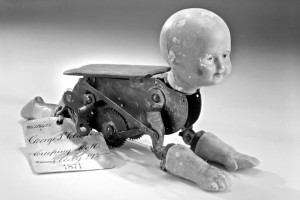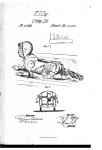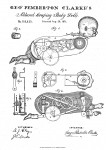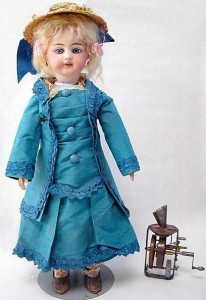 I was reading this article and watching the associated video about the robots in the National Museum of American History which is an interesting look into the Smithsonian’s extensive collection of mechanisms, from a 16th century spring-wound automaton of a monk to C3PO to cutting edge miniaturized robots. It includes a picture of a crawling children’s doll patented in 1871. It’s strikingly scary looking but the story provides no information beyond the bare bones caption (“Model for a creep baby doll, which was patented in 1871”), and it’s not even in the video, so of course I had to search high and low to find out more about this AI Chucky.
I was reading this article and watching the associated video about the robots in the National Museum of American History which is an interesting look into the Smithsonian’s extensive collection of mechanisms, from a 16th century spring-wound automaton of a monk to C3PO to cutting edge miniaturized robots. It includes a picture of a crawling children’s doll patented in 1871. It’s strikingly scary looking but the story provides no information beyond the bare bones caption (“Model for a creep baby doll, which was patented in 1871”), and it’s not even in the video, so of course I had to search high and low to find out more about this AI Chucky.
First of all, creeping is what they called crawling back then, and as recently as the early 19th century the question of whether babies should be allowed to crawl was still hotly debated. Crawling was what crazy people and animals did and as such was morally suspect, even “unnatural” for a sane human. By the mid-1800s, however, crawling was seen as a natural stage of childhood and the popularity of devices such as the standing stool began to wane.
Meanwhile, as industrial mass production took over from individual toy makers and technology itself became a source of convenience and fascination, dolls with clockwork elements became increasingly popular toys. Instead of the rag doll with a change of clothes, wood, ceramic, and metal automata put on a show of blinking eyes, moving limbs and mouths, or two faces that would turn with a flip of a switch. Dollmaking was  becoming the province of inventors and machinists, not just designers. After the Civil War, American dollmakers tried to get a piece of the action by upping the mechanization ante. The baby doll with a wax head and a crawling motion powered by an internal clockwork mechanism was an attempt to tap into this trend.
becoming the province of inventors and machinists, not just designers. After the Civil War, American dollmakers tried to get a piece of the action by upping the mechanization ante. The baby doll with a wax head and a crawling motion powered by an internal clockwork mechanism was an attempt to tap into this trend.
Now a correction: although it’s certainly a creep, it’s actually called a “Creeping Baby Doll” and was first patented by Robert J. Clay on March 14, 1871. In the application, he describes his creepy baby as “a very amusing toy…produced at small cost.”
 The prototype in the Smithsonian, however, is a slightly later iteration. Clay’s patent was number 112,550. The creep baby on display at the National Museum of American History is the patent model for patent number 118,435, submitted by George P. Clarke and accepted on August 29, 1871. Clay was Clarke’s boss and the later patent was an improvement on Clay’s original model.
The prototype in the Smithsonian, however, is a slightly later iteration. Clay’s patent was number 112,550. The creep baby on display at the National Museum of American History is the patent model for patent number 118,435, submitted by George P. Clarke and accepted on August 29, 1871. Clay was Clarke’s boss and the later patent was an improvement on Clay’s original model.
Despite Clay’s belief that his toy would be very amusing, it had limited appeal for its target audience of little girls. It looks scary, weighs a lot and isn’t particularly interactive. It’s more of an exhibition piece than a cuddly toy, and once the mechanism broke (which happened often with the earlier models), its heaviness and hardness made it a dead weight rather than a doll that could be integrated into regular play.
 Even Thomas Alva Edison’s foray into mechanized dollmaking was a playtime failure, although interesting as a display piece. He invented the first talking doll in 1877 (sold to the public starting in 1890). It was a tall, 22″ doll with a metal body and a bisque head with a wee phonograph inside that was operated by a key in the back. When the key was turned, the phonograph would play a wax cylinder. This was the first phonograph sold for home use, so it’s an important stepping stone in the history of entertainment technology. The only problem was the child had to turn the key steadily at the proper speed the whole time to hear the doll speak, and since you couldn’t switch out the cylinder, once the needle wore it down, that was the end of Chatty Cathy. Oh, also, Edison himself described the sound produced in less than flattering terms. He said “the voices of the little monsters were exceedingly unpleasant to hear” and he wasn’t lying, let me tell you.
Even Thomas Alva Edison’s foray into mechanized dollmaking was a playtime failure, although interesting as a display piece. He invented the first talking doll in 1877 (sold to the public starting in 1890). It was a tall, 22″ doll with a metal body and a bisque head with a wee phonograph inside that was operated by a key in the back. When the key was turned, the phonograph would play a wax cylinder. This was the first phonograph sold for home use, so it’s an important stepping stone in the history of entertainment technology. The only problem was the child had to turn the key steadily at the proper speed the whole time to hear the doll speak, and since you couldn’t switch out the cylinder, once the needle wore it down, that was the end of Chatty Cathy. Oh, also, Edison himself described the sound produced in less than flattering terms. He said “the voices of the little monsters were exceedingly unpleasant to hear” and he wasn’t lying, let me tell you.
Click, if you dare, on play to hear the Little Jack Horner cylinder:
[audioplayer file=”http://www.thehistoryblog.com/wp-content/uploads/2011/05/EdisonTalkingDoll-LittleJackHorner1890_64kb.mp3″ titles=”RUN, RUN FOR YOUR LIFE”]
That recording sounds like a parrot saying the Lord’s Prayer backwards. :boogie:
Every morning I eagerly go to The History Blog to see something new and different about who-knows-what. Today’s post is especially well prepared and comprehensively covers a topic totally beyond my personal experience. Who knew that a doll was the first phonograph sold for home use? Thanks, too, for the tip on patent drawings.
True, also I’m pretty sure Paul McCartney is dead for real now.
Thank you kindly, Mr. Murphy. I’m delighted to have introduced a new interest, especially since it’s relatively new to me since I’m not a doll aficionado or even remotely knowledgeable in the area. I had no idea about the phonograph either. This is one of the great joys of the Internet: you can pursue a topic and find out all kinds of new things about it. 🙂
Listening to that recording while looking at the creeping baby made me wonder why nobody has made a horror movie from these historical artifacts yet.
It’s Twilight Zone all over again!
MY NAME IS TALKING TINA AND I DON’T LIKE YOU!
:ohnoes:
I’ve been wondering that myself. Chucky is nowhere near as scary as Creeping Babby. Add the phonograph voice and you’ve got the stuff nightmares are made of.
http://download.lardlad.com/sounds/season4/thohc5.mp3
I very much enjoyed your blog. 🙂
I came across this website the other day which may interest you, You can download Thomas Edisons eStory for free, It’s been written in a first person view, Almost like an interview with Edison himself, Feels like you traveled back in time! You can download the eStory or audio for free at http://www.amazingpeopleclub.com and just join the club for free.
Other than that, Very interesting blog, And a very creepy voice clip!
I’m glad you told me what the doll was supposed to be saying.
Geez, no wonder laudanum was legal.
😆 I hope they made it in chewable Flintstones vitamin form for the kids forced to play with those dolls.
I have a follow-up post about those scary buggers here. The “Twinkle twinkle little star” cylinder less sounds a little less like Satan coming to kill you.
We’re so sorry Uncle Albert…
Man, the very first reborn baby doll in the making! Crazy how far baby dolls have come since then. 😆
Man, the very first reborn baby doll in the making! Crazy how far baby dolls have come since then.